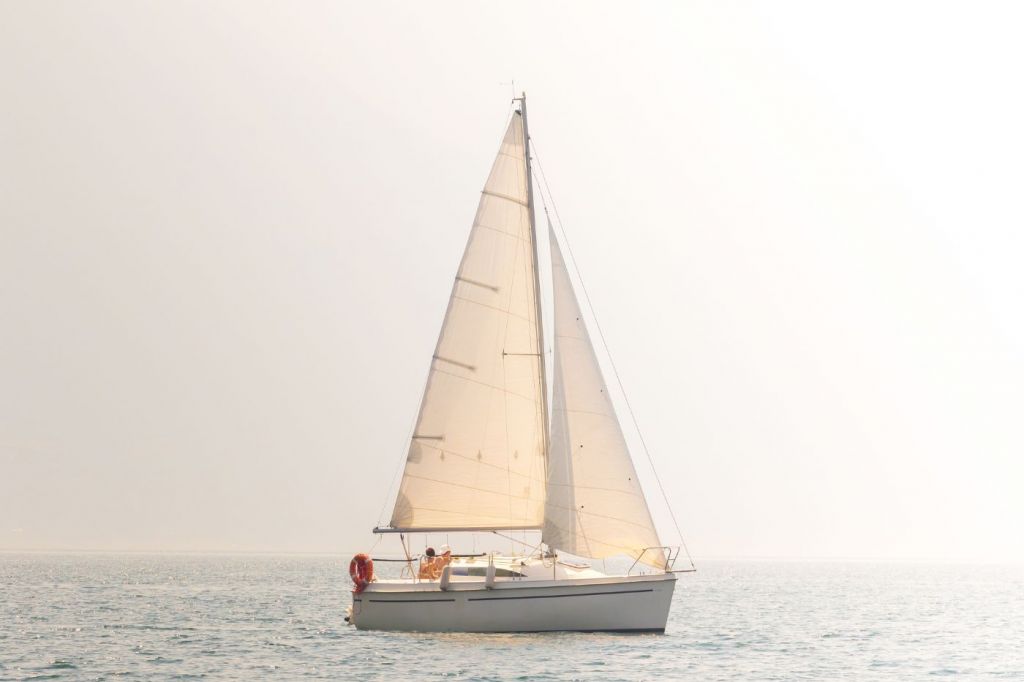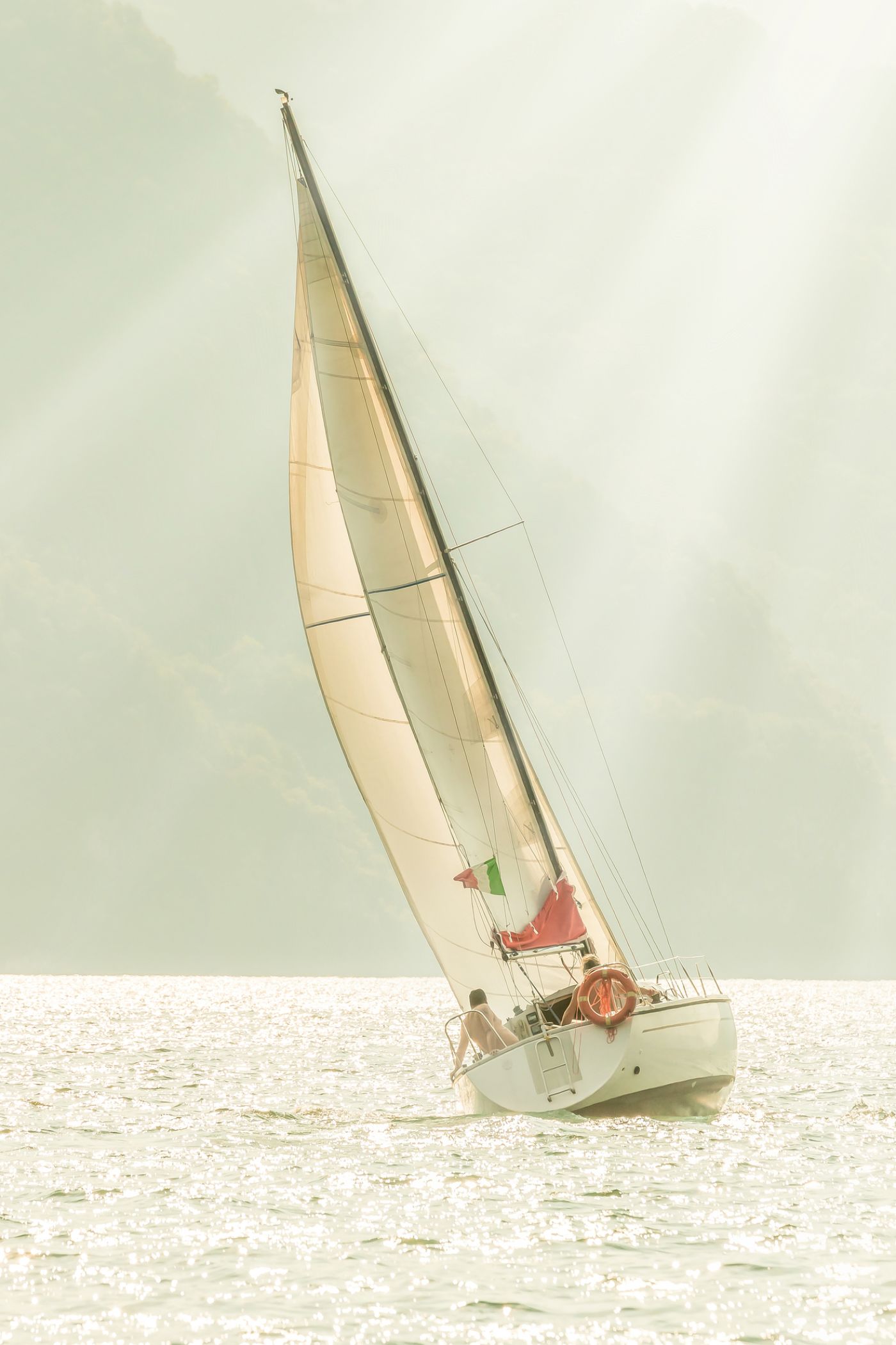Raising the Mainsail Single Handed: 5 Pro Tips
Single-handed sailing can be the most rewarding time you spend on your boat. And nothing makes you feel like a rockstar like sailing past a boat full of people by yourself when your boat looks fast and trim. But little feels worse than messing something up and spending half an hour grunting and sweating in front of a crowd to fix it.
Getting your mainsail up can be a challenge when single handing. So what are some tips to get the sail up?
Here are five solid tips to improve your single handed main hoists:
- Fix your rudder in place
- Use the right sail management systems, like lazyjacks, a Dutchman, or a Stay Pack
- Replace your bolt rope with slugs or sliders
- Use properly placed line clutches - especially rope clutches come in handy
- Prepare your sails and rigging dockside

1. Fix Your Rudder in Place
You want to keep your rudder in place so you can stay head-to-wind while you set the main. A boat spinning around off the wind will make setting a main much more difficult, so you need that rudder locked.
The easiest to use is an autopilot. If you have one, just engage it in "auto" heading mode when you go head to wind. That should hold you while you work.
If you have a smaller boat without an autopilot, figure out a temporary arrangement to keep the wheel or tiller centered. It should be quick to engage, and easy to get off.
Bungy cords on a tiller are easy. You'll need two, one to each side of the boat, clipped or wrapped on a stanchion, padeye or other convenient place. With no sails up, there won't be a lot of load on the tiller, but you need to keep it from flopping.
You can also use short pieces of line with a tiller, but be careful using a single length. Don't just loop the line around the tiller in the middle, since the tiller can slide through a loose loop. A clove hitch around the tiller in the middle of the line will stop the slippage and is easy to remove.
Many wheels have wheel locks, but they aren't strong enough to handle sailing loads. You shouldn't have high loads without sails up, but an unexpected wave might knock a rudder locked with a wheel lock. I prefer it as a backup only.
Like a tiller, you can use bungy cords to hold a wheel, or find another way to lock it in place with easily removed lines.
2. Sail Management Systems
On my boat, I can set, reef and douse my main from the cockpit without leaving the wheel. While hydraulic furling and power winches aren't the norm, they are one example of sail handling systems to make your short-handed experience easier.
Stack packs, Dutchman systems, lazyjacks, and other systems help your solo main handling. Some of them are a lot more help to douse the sail than set it, but a sail reined in by one of these systems goes up better. Most of them keep the sail from sliding all over the place and getting out of hand and caught by the wind while you're setting it.
- Lazyjacks are a set of lines run from partway up the mast to the boom. Their function is to collect the sail as it drops to help flake it to the boom. It also provides some containment as the sail comes up, though you need to take some care not to snag battens on the lines.
- A Dutchman system installs nylon lines vertically through the main from a topping lift down to the boom. During the hoist, the sail slides up and down these lines and flakes automatically on the drop. The foot of the sail is tight to the boom to help this, and the sail can not escape while you're hoisting.
- A Stack Pack is a hybrid of lazy jacks, a fully battened main, and a canvas cover permanently installed to the boom. The sail flakes down into the pack, and launches from it, easing handling going up and down.
Main furling makes setting the sail easy. There are two types of main furling - mast furling, and boom furling. Mast furling can be in-mast, or it can be retrofitted with a system outside the mast.
Both systems are major upgrades to a boat, so consult a rigger to make sure your mast and boom can handle the loads. You can't retrofit in-mast furling to an existing spar, and there’s a good chance you’ll need to need to replace the boom for some boom furling systems.
In-mast furling affects sail shape and performance (you can’t have a big roach or horizontal battens), and any furling system can get jammed. So while furling systems aren't a quick fix, they are something to think about when buying a boat to solo sail, or to explore retrofitting if you spend most of your time sailing alone.

3. Sail Tracks and Bolt Slugs
A sail with a bolt rope gives the best airflow from sail to mast. But it's not the easiest setup for hoisting single handed since the sail isn't left on the mast, there’s lots of resistance from the bolt rope when hoisting, and you may need to feed the rope into the track if it pops out. A rope feeder helps, but can still bind and come out.
Replacing your bolt rope with slugs (or sliders) is a practical way for a solo sailor to keep a main in the mast when it's doused and hoist it quickly. The slugs go in the same track as the bolt rope, but you can add a lock on the bottom to keep them from sliding out once the sail is bent on. They also have much less resistance in the sail track than a bolt rope, so the hoist is easier.
You can fit mainsail track and car systems on a mast, and have similar advantages to slugs and sliders. The main can stay on the boom, and there’s a lot less friction on the hoist.
The other advantage to sliders, tracks, and slugs is that with smaller boats with lighter sails, you can run your halyard back to the cockpit and hoist from there. Hoisting a sail when you can reach the helm gives you a lot of options.
4. Line Controls and Clutches
A line clutch in the right place is as good as an extra pair of hands. A few well placed controls - rope clutches in particular - can make a big difference to how you get your main up by yourself.
Picture hoisting the halyard - you get partway up, then notice you missed a sail tie down by the end of the boom. You have to either let the halyard down, or put it on a cleat while you step back by the outhaul get that annoying sail tie off. But if you've put a clutch on your mast for the main halyard, you can just step away from it to deal with the problem without losing your hoist.
Having your hoist held by a clutch (or even a cam cleat on a smaller boat) gives you that extra option to use your other hand for something else without dropping the main. If things go sideways, you may not want to lower the halyard to deal with it if the luff isn’t the problem.
A line clutch or cam cleat on the mast halyard should be backed up with a cleat to tie it off.
5. Plan Ahead
The best tip to help your sail handling is to plan well and do as much as you can dockside to make your life easier when you're out on the water. Anything you do solo is more work, and everything you do on a pitching boat away from the dock takes longer than when you're tied up. Preparing before you go out saves a lot of aggravation.
- Bend on the sails, if you don't store your main on the boom. Get the sail on the boom before you leave (see “bolt slugs”). You don't need to put the halyard on, but a sail ready to hoist will save you a lot of hassle.
- Run any rigging you store away and connect it to the sail as needed.
- Get the sail cover off and put it away. It's one less thing to keep your hands on.
- Set up the lines and cords for securing the rudder and keep them handy.
The other area to plan is the setup of the boat. As several of these tips imply, there are many ways to get your boat set for optimal soloing, but they aren't things you can come up with on the spot. You need to think them through and sometimes make some major upgrades or choices when buying your boat.
Did you find the answer to your specific question?
👍 4 👎 2
Leave a comment